Affiliate marketing allows anyone with a website to earn money online, whether you’re a casual blogger or an internet marketer overseeing multiple sites.
Similar to other business models, affiliate marketing comes with its own set of rules and legal obligations. While these rules may differ based on your business location or the affiliate program’s Terms of Service, one common requirement stands out:
You must clearly and understandably disclose your affiliate links.
This article will guide you on how to do that effectively. It will also show examples from successful affiliate websites, demonstrating how they disclose their advertising relationships transparently.
What Is An Affiliate Disclosure?
An affiliate disclosure is like a note on your blog, website, or video that tells people about your connection with the company selling the product/ service you talk about. It’s just a way of being honest with your audience.
Why is it important? Think about reading a super positive review about a fitness tracker only to discover it was sponsored. The trust in that review disappears, disclosures prevent that by keeping things transparent and ethical in marketing.
So what does it look like?
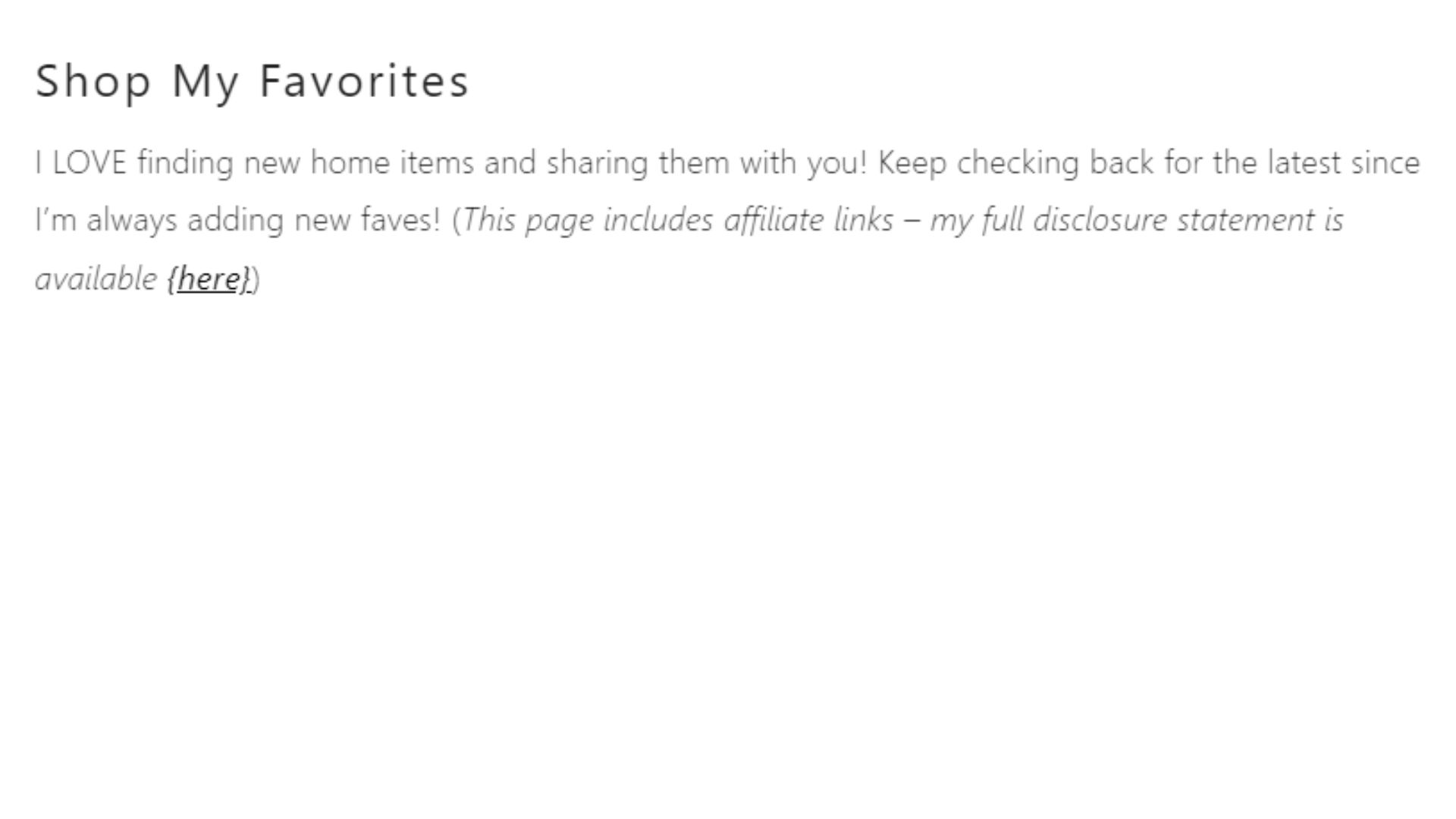
It’s easy! A sentence in your content, like: “FYI: I’m affiliated with [company name] and might earn if you buy through my links.” You can also have a separate page with more info about your affiliate connections.
Remember: Disclosures are all about being open. Be clear, be honest, and let your readers know when you’re teaming up with a company. It’s a small step that goes a long way in building trust online.
Top 15 Affiliate Disclosure Examples to Follow
Now, let’s look at some examples to help you with your affiliate disclosures.
You can use them as inspiration; don’t copy them exactly. Make them your own to keep things authentic and ethical.
Remodelaholic
Remodelaholic is a go-to source for home improvement, interior design, and remodeling inspiration. They provide valuable content and have a detailed description on the “Privacy Policy & Disclosures” page.
In which, Remodelaholic shares info about getting paid for opinions, marks sponsored posts, and uses affiliate links. If you buy through those links, they may earn a commission. They’re in Amazon Associates and partner with Raptive for ads. It’s a quick way to let you know about their links and partnerships.
Luckily, she adds jump links for easy scrolling to specific sections, like affiliate info. If you adopt this method with a dedicated affiliate disclosure page for all legal details, it ensures a good user experience—no endless scrolling to locate disclaimers.
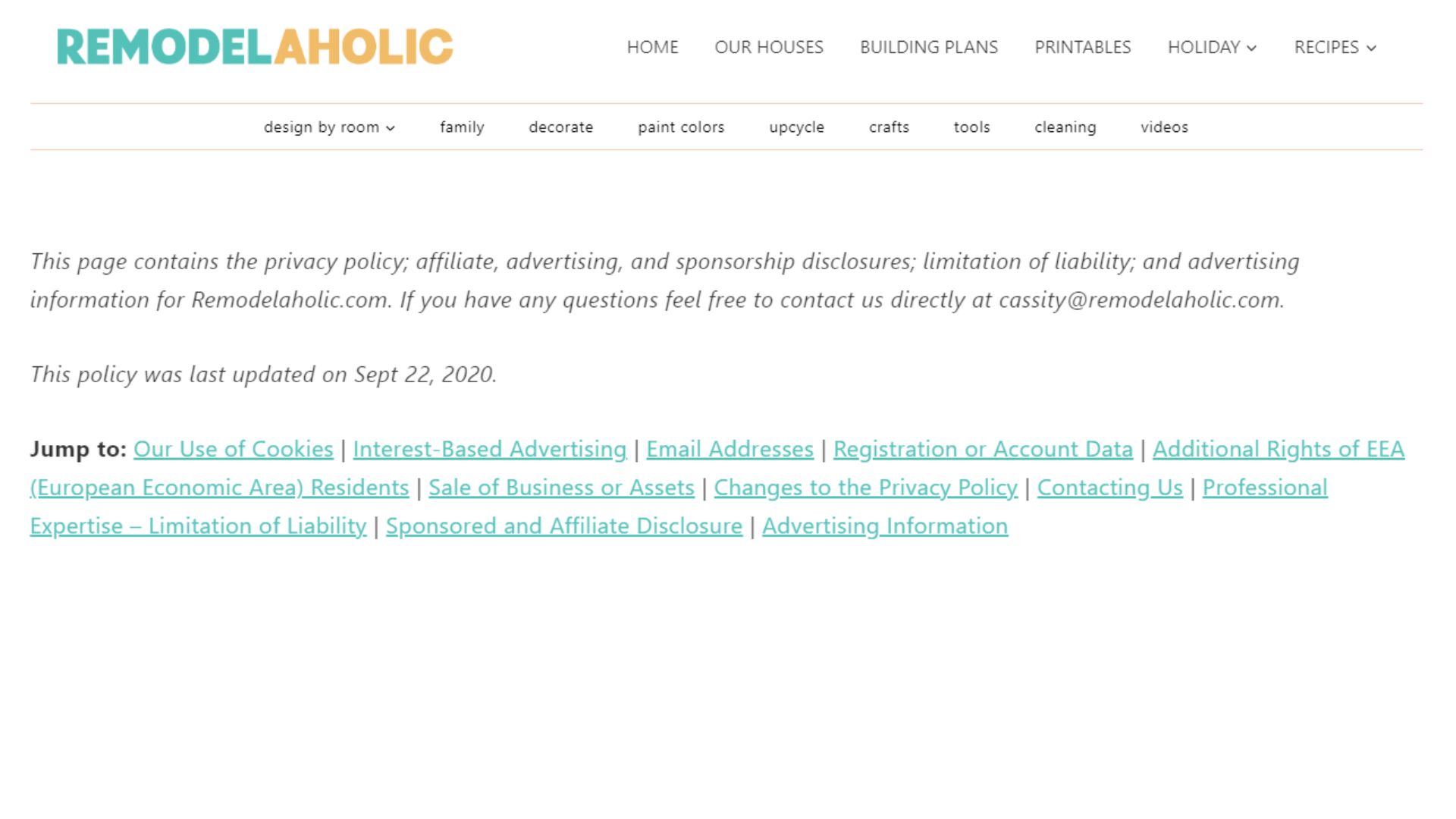
Cassity ensures transparency by openly communicating with readers about possible financial connections between the blogger and the mentioned products or services within the blog content.
She includes a statement like “This post contains affiliate links. Learn more and read our full affiliate disclosure policy here,” directing readers to the Privacy page for additional details.
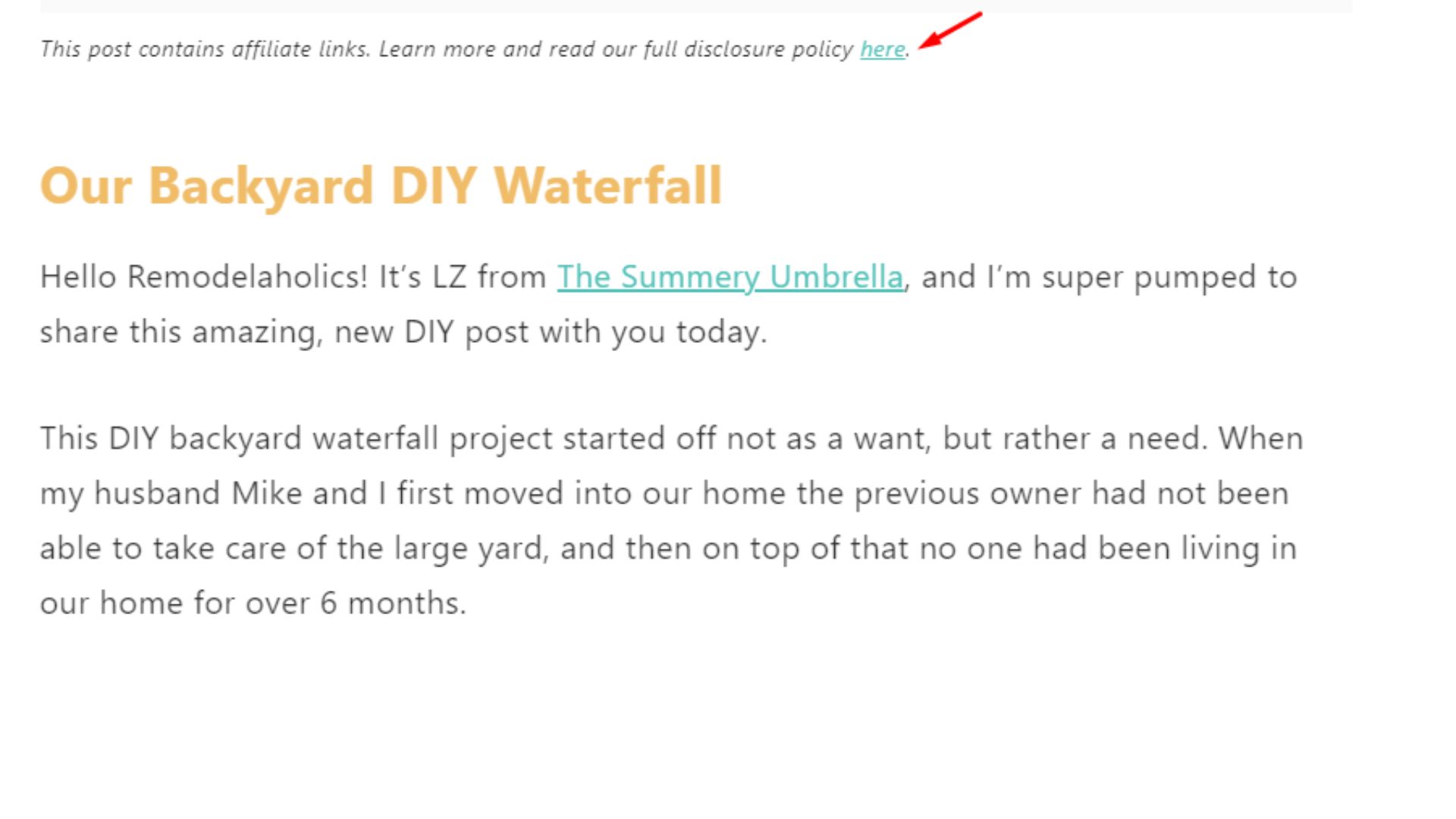
The Point Guy
“The Points Guy” is a popular affiliate marketing website that provides information and legal advice related to travel, particularly in the context of loyalty programs, credit card rewards, and points systems.
The Points Guy has two disclosure messages on his website.
The first one is in the footer, mentioning he receives compensation from credit card companies for the displayed offers.
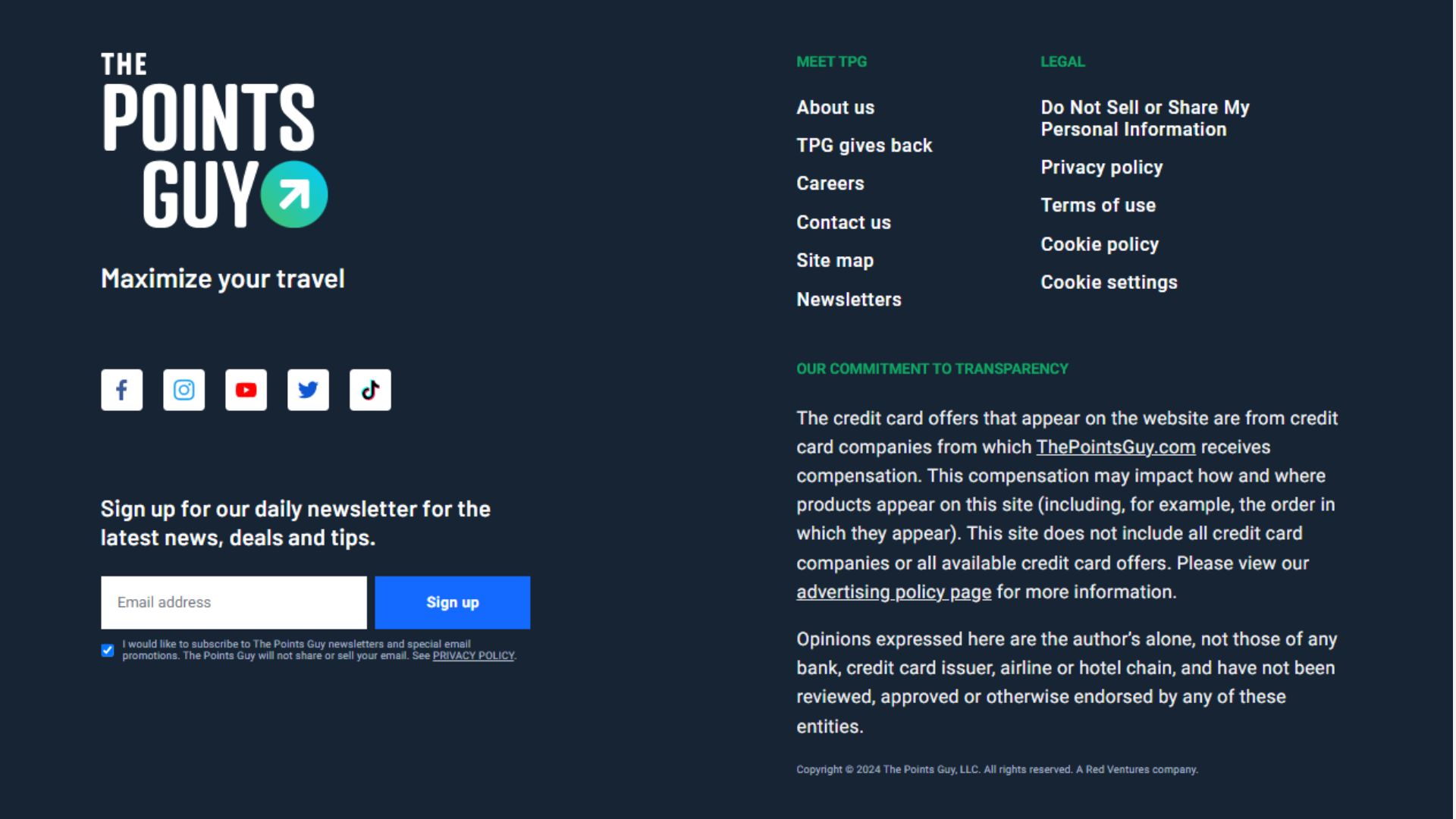
The second, similar to the first, is visible on every page. Both disclosures use a distinct font and size, making sure they’re easily noticed by the reader.
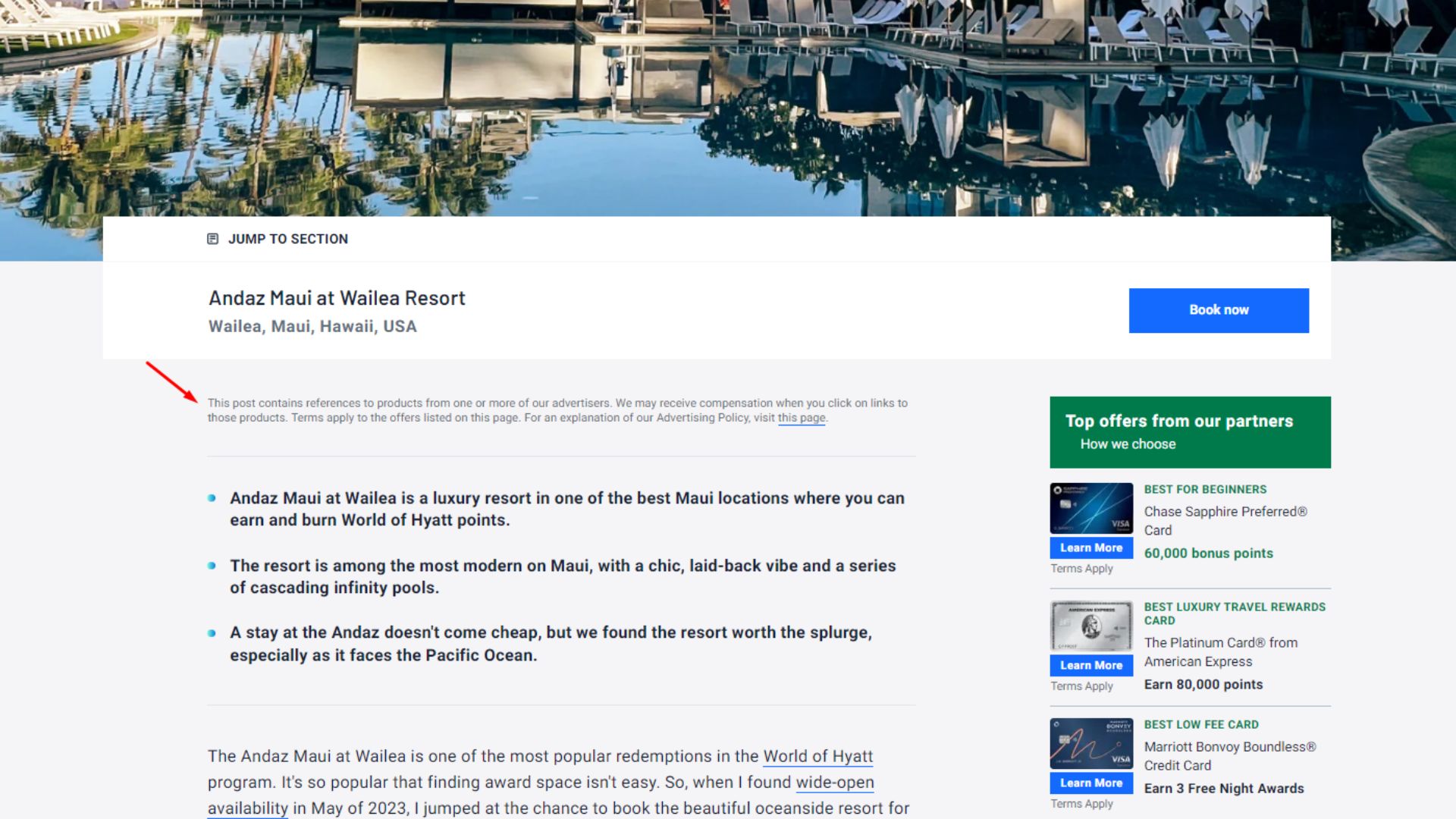
Dan Flying Solo
Dan Flying Solo is a travel blog and photography site run by Dan. He shares his adventures exploring Asia, Europe, and Australia. The website has travel guides, tips, and stories to help you plan your next trip.
For each post, he pinned an affiliate disclosure at the top of the page after the title, stating that “This website uses affiliate links which may earn a commission at no additional cost to you. As an Amazon Associate I earn from qualifying purchases.”

Not only that, but Dan Flying Solo makes it explicit in any travel sponsored by tourism entities. For instance, in his article on Sustainable Travel Tips, he mentioned that his trip to Austria was supported by Austria Tourism, ensuring transparency about the sponsorship.
The DIY Nuts
The DIY Nuts covers many DIY topics, including home projects, painting ideas, and various easy DIY projects. The site aims to inspire and guide individuals in creating and enhancing their living spaces through creative and cost-effective DIY solutions.
The DIY Nuts combines its disclosure with the privacy policy, even though the FTC advises against it.
However, they effectively distinguish the discussion of disclosure and privacy issues.
Their pre-content disclaimer on posts is transparent, stating they only recommend products they would use, with an honest tone and a link to the full disclosure page.
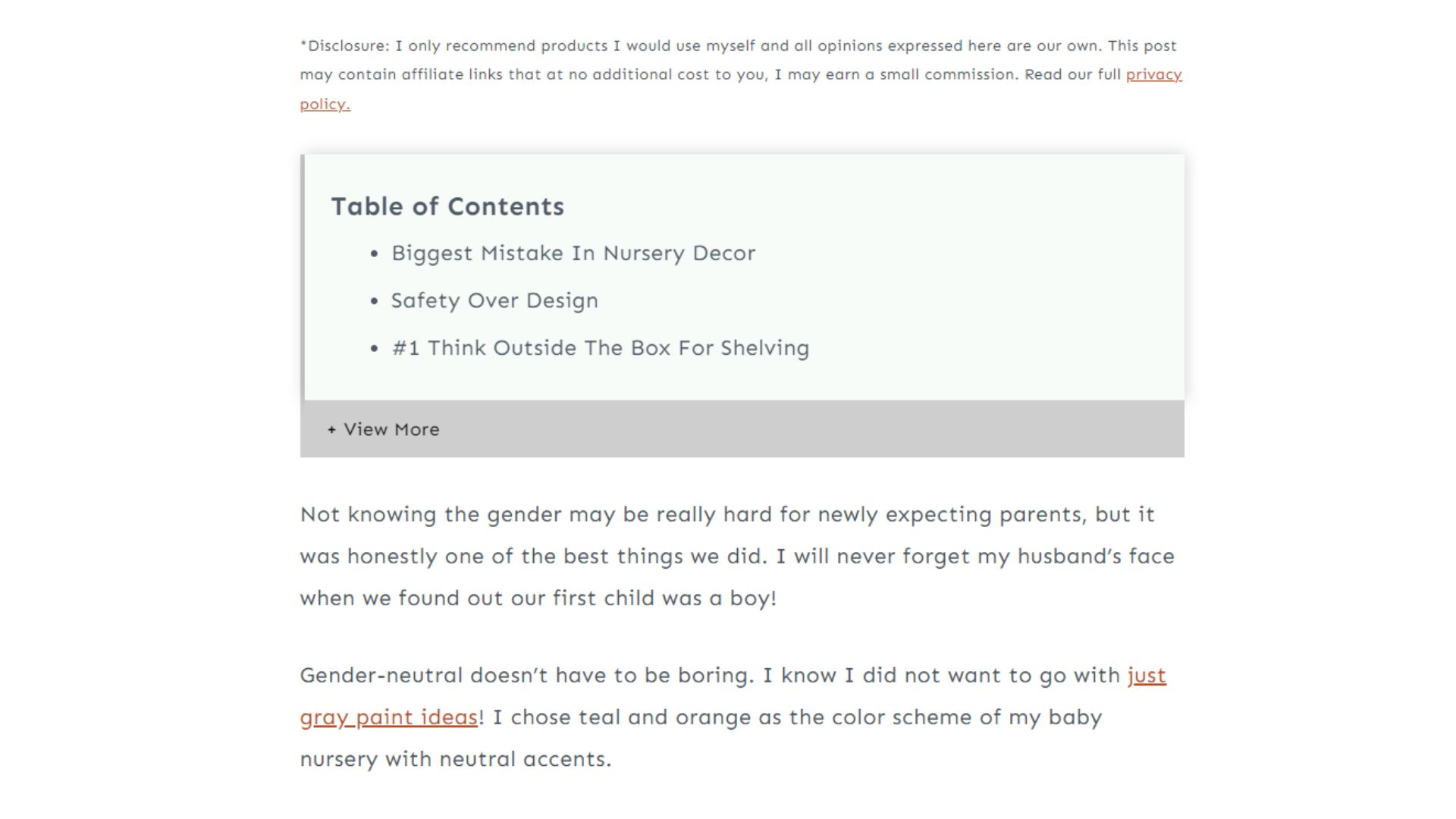
*Disclosure: I only recommend products I would use myself and all opinions expressed here are our own. This post may contain affiliate links that at no additional cost to you, I may earn a small commission. Read our full privacy policy.
Engadget
Engadget, a large website with numerous online product reviews, prominently places their affiliate disclosure at the top of each page containing a product review.
They mentioned why you can trust them: “Engadget has been testing and reviewing consumer tech since 2004. Our stories may include affiliate links; if you buy something through a link, we may earn a commission.”
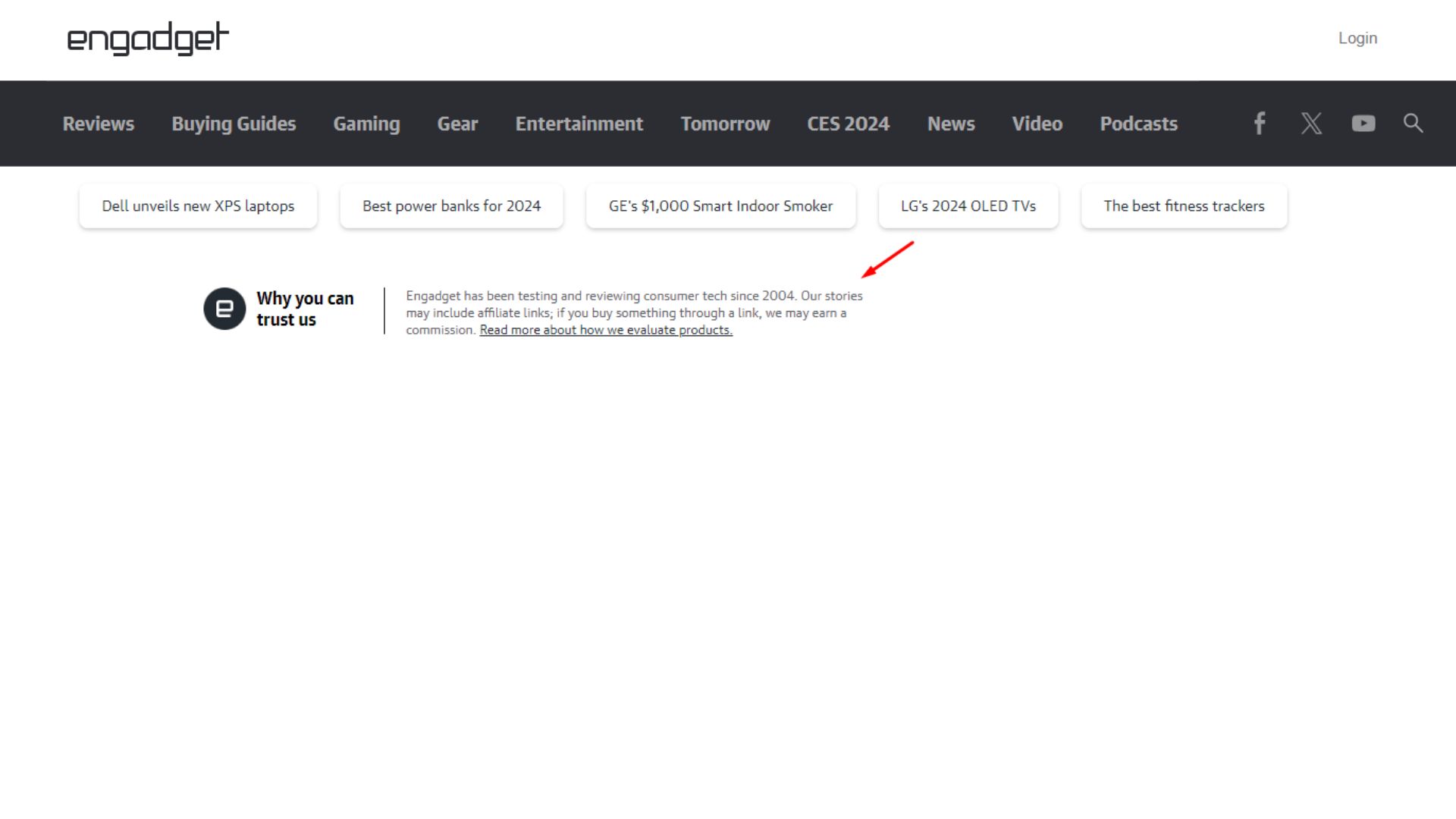
They also have a special web link that takes you to a page explaining why you can trust them.
This page is important because it tells you that Engadget is honest about its reviews, it makes its own choices, and sometimes it earns money if you buy something using the links on its site.
They want you to know they’re fair and test products seriously. They also explain how they handle special deals and sponsored content so you can trust them more.
Additionally, they reference their third-party links in their privacy policy. The concise disclosure explicitly states that they endorse all products and may receive affiliate commissions.
The Prepared
The Prepared is a media company founded by John Ramey, offering disaster preparedness or potential zombie takeovers content without fear-mongering.
It provides reviews, how-to videos, and practical advice for a broad audience, aiming to change the lone wolf stereotype.
Because The Prepared caters to a naturally skeptical audience, it ensures its affiliate disclosure is clear and trustworthy!
The team at The Prepared ensures transparency by prominently showing their affiliate disclosure on the side of their main landing page.
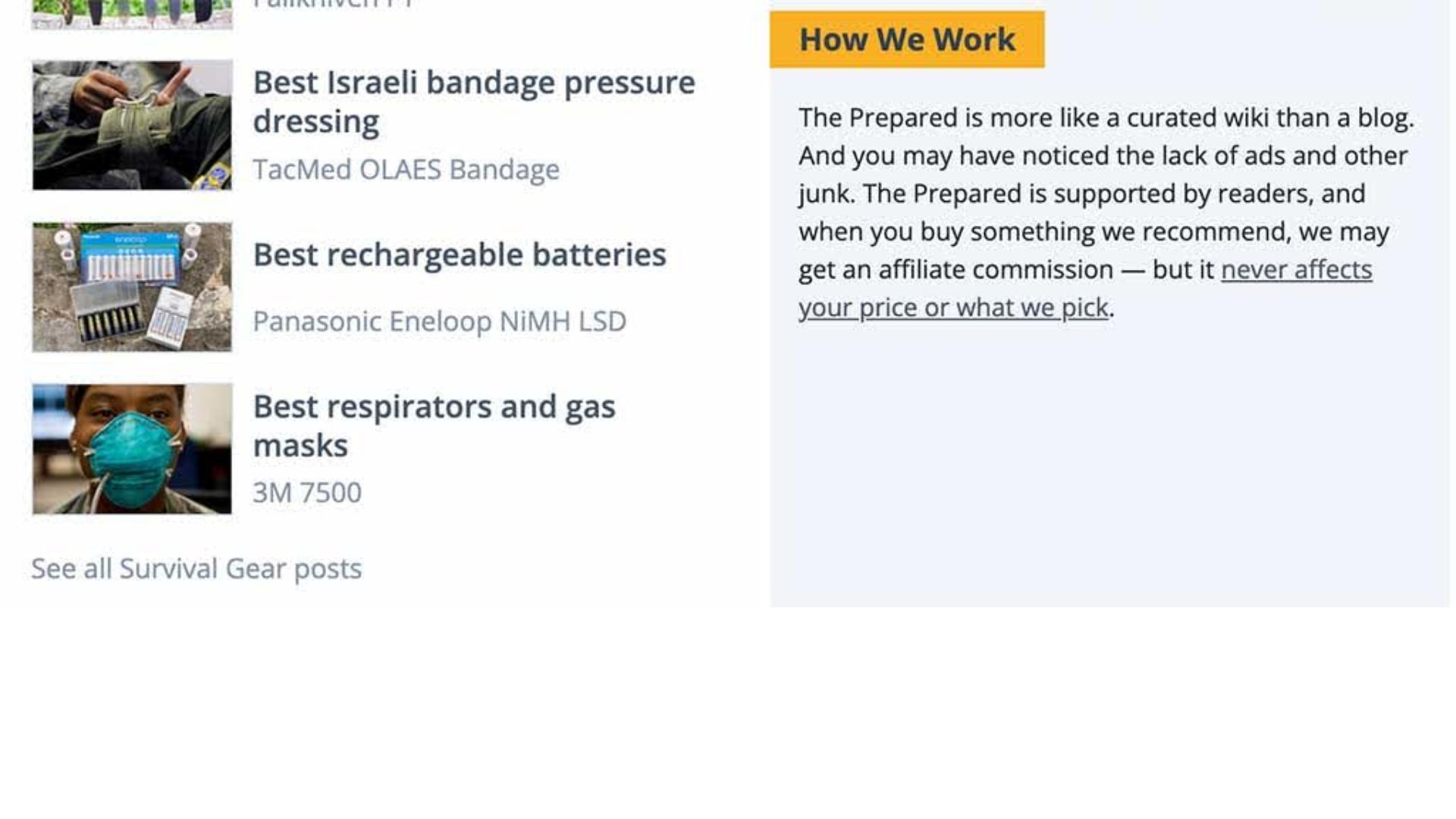
This practice is consistent across all pages, including blog posts and reviews. However, it is suggested that the affiliate disclaimer could be more noticeable if placed at the top-left rather than the bottom-right of the page.
SmartBlogger
SmartBlogger.com is upfront about their affiliate relationships. You’ll find their affiliate disclosure on the resource page, where they explicitly mention earning a commission if you buy through their referral links.
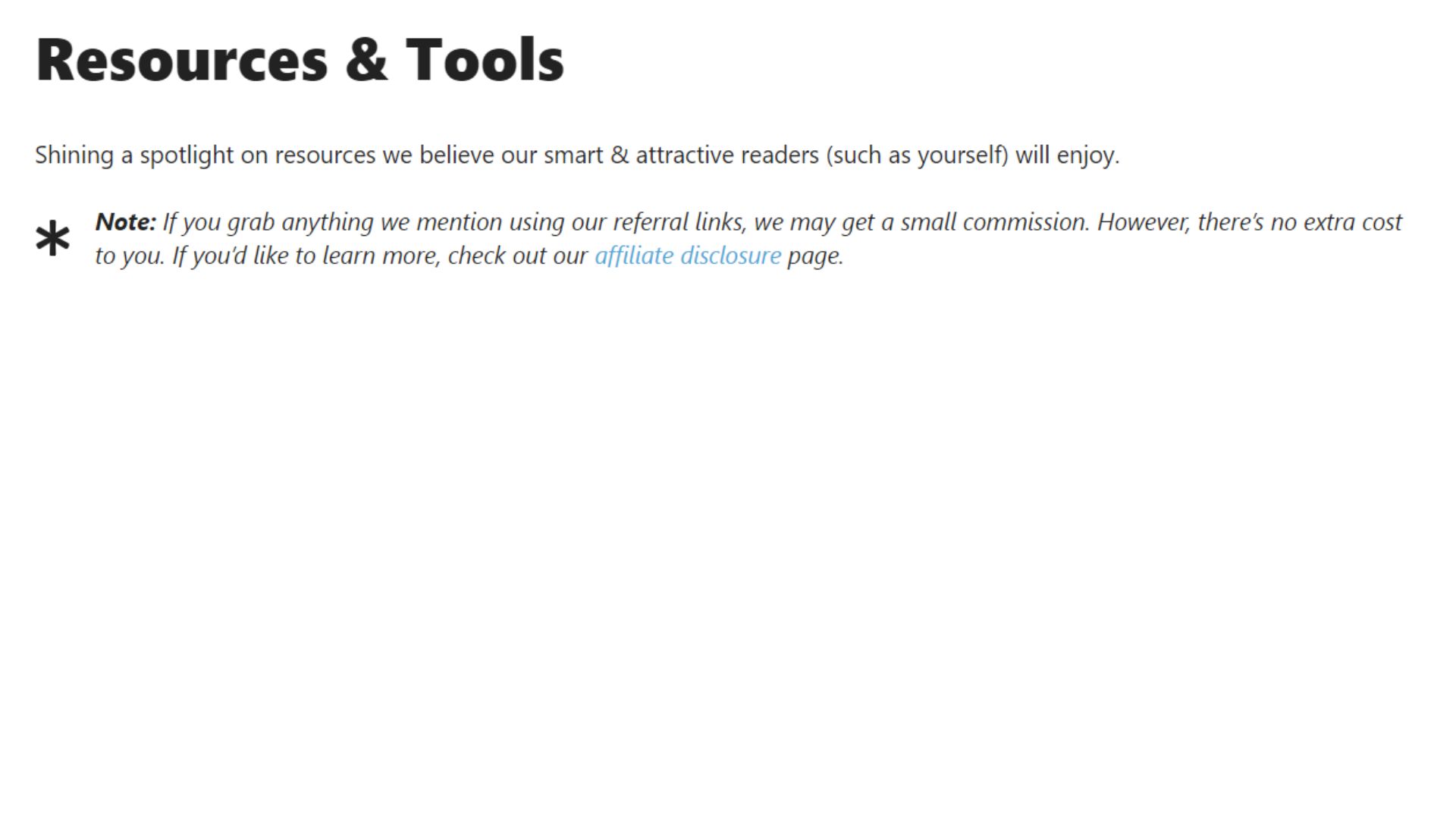
They also provide a link at the end of this disclosure to their main affiliate disclosure page for more details.
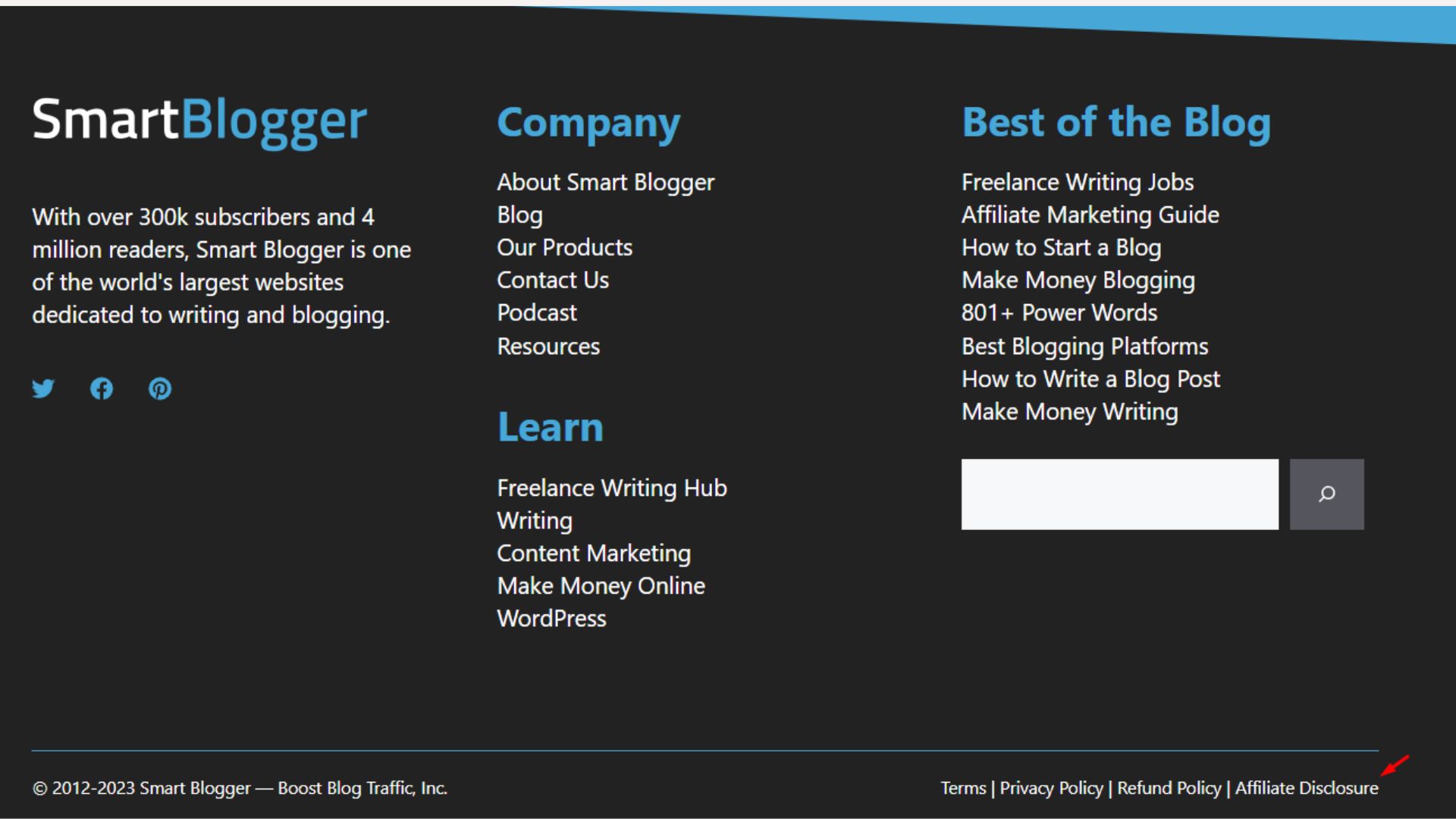
While they don’t repeat this disclaimer on every page, a link in the footer (visible disclosure on every page) directs you to their main affiliate disclaimer.
This disclaimer not only informs you about affiliate links but assures you that any such links will be labeled with the words “Affiliate Link” in brackets.
This way, anyone clicking on the link will be aware that it’s an affiliate link.
CryptoVantage
CryptoVantage aims to simplify the process of buying cryptocurrency and make it more accessible globally. It offers information on different cryptocurrencies like Bitcoin and Ethereum, along with news, features, and opinions about the crypto industry.
Take a peek at how CryptoVantage handles affiliate disclosure on their site. In the past, their reviews only had the words “affiliate disclosure” at the top, leaving readers to hunt for it.
Check out how CryptoVantage now shares their affiliate disclosure.
Before, it was just the words “affiliate disclosure” at the top of their reviews. Now, you need to scroll to the bottom of the page, past any affiliate links, to find a more detailed disclosure.

They’re still working on it, but it’s an interesting approach!
Wirecutter
Wirecutter is a product recommendation website owned by The New York Times Company. he site provides in-depth reviews and guides on a wide range of consumer products, helping users make informed purchasing decisions.
And it is really good at being transparent.
In their articles where they recommend products and provide links, they make it clear that they may earn a commission if you make a purchase through those links.
“We independently review everything we recommend. When you buy through our links, we may earn a commission.“
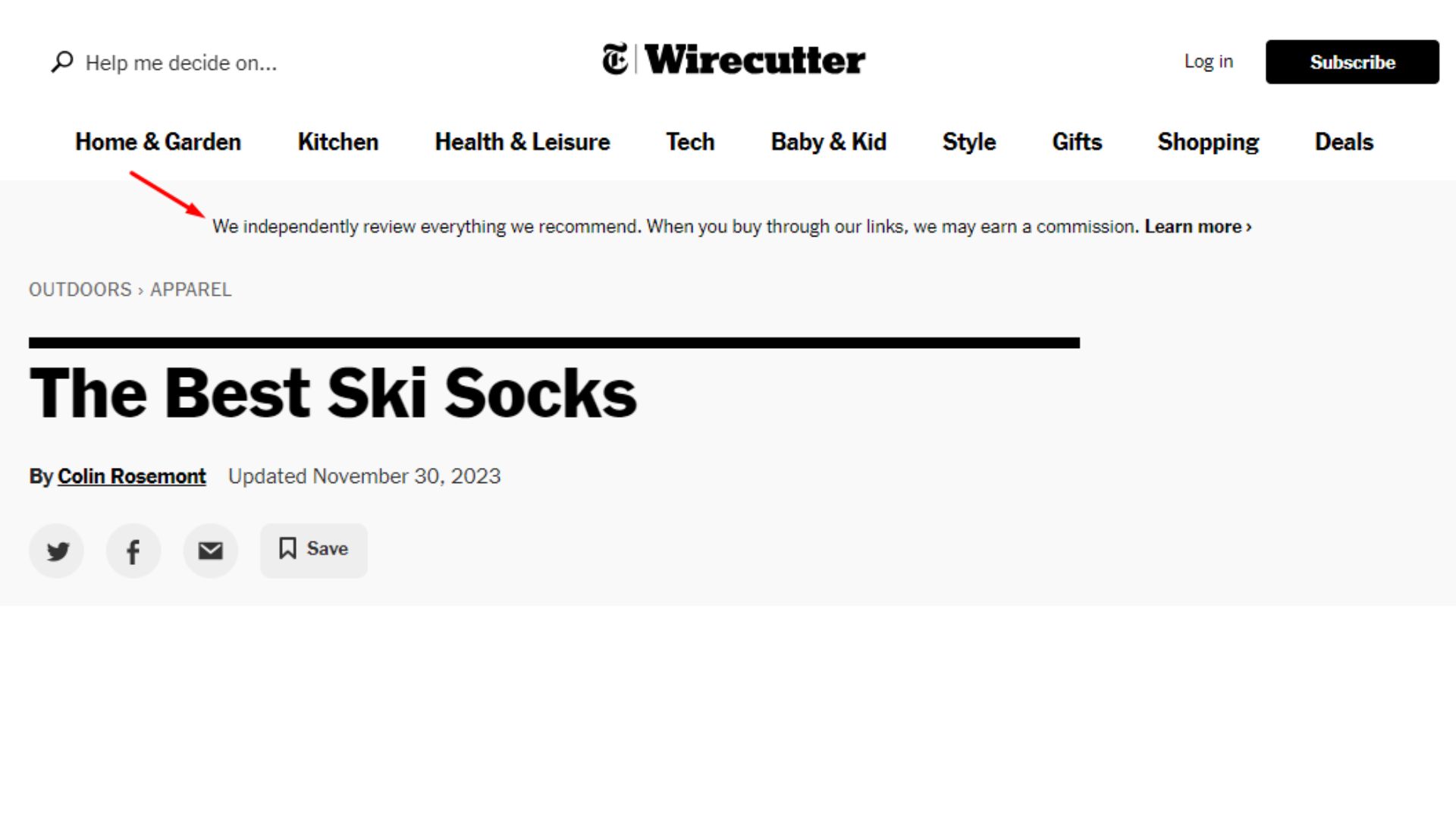
On the Wirecutter “About Us” page, they provide insights into their product selection process, explain their approach to affiliate marketing, and emphasize their commitment to objectivity.
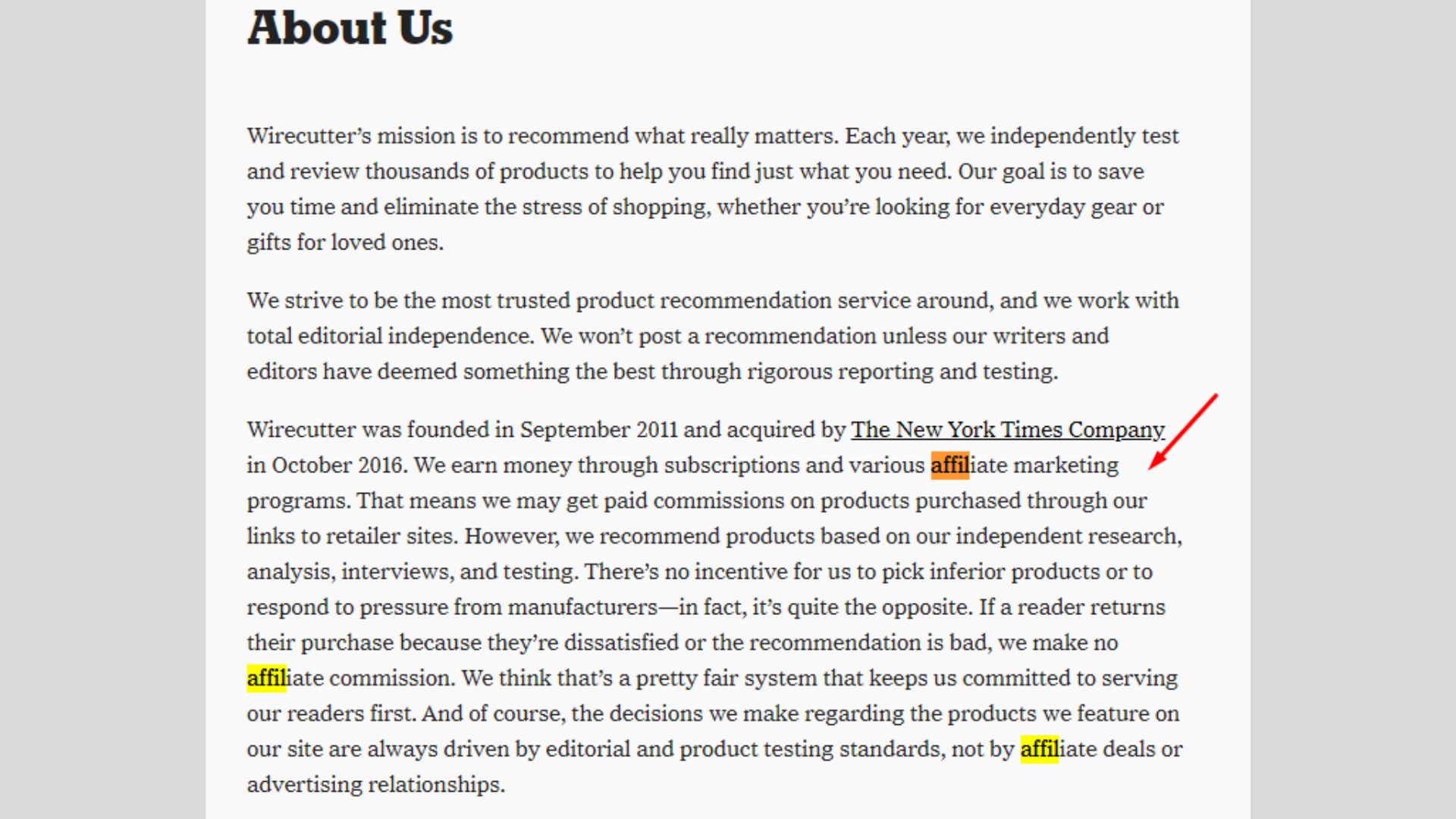
They present this information in a straightforward Q-and-A format, making it easy for readers to understand their content and recommendations.
Tech Radar
TechRadar is super upfront about things. They’ve got this short and sweet disclosure about using affiliate links.
They give a shoutout to their awesome audience, and let you know about those affiliate links, and if you’re curious for more details, they’ve got a link for you.
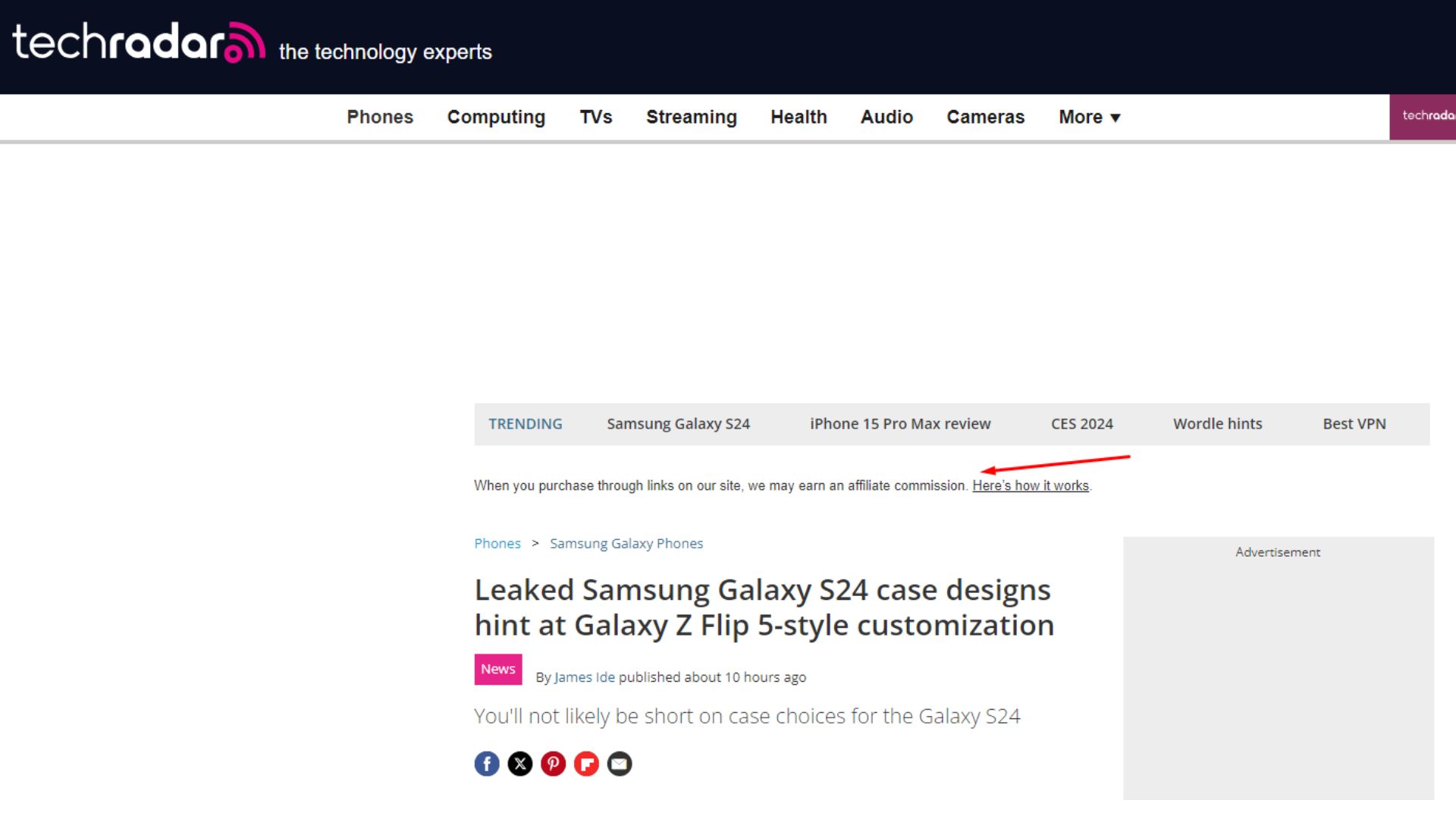
When you visit TechRadar’s “About TechRadar” page, they lay it all out. They answer questions like, “Is TechRadar Pro reliable?” or “How does TechRadar make money?” and spill the beans on how they earn commission through affiliate links.
Simple and to the point, TechRadar nails it with their disclaimer game.
Ken’s Tech Tips
At Ken’s Tech Tips, they keep their disclosure straightforward.
Ken’s Tech Tips has its affiliate disclosure smartly positioned in the “About Ken’s Tech Tips” section, providing an introduction to the website and its purpose.
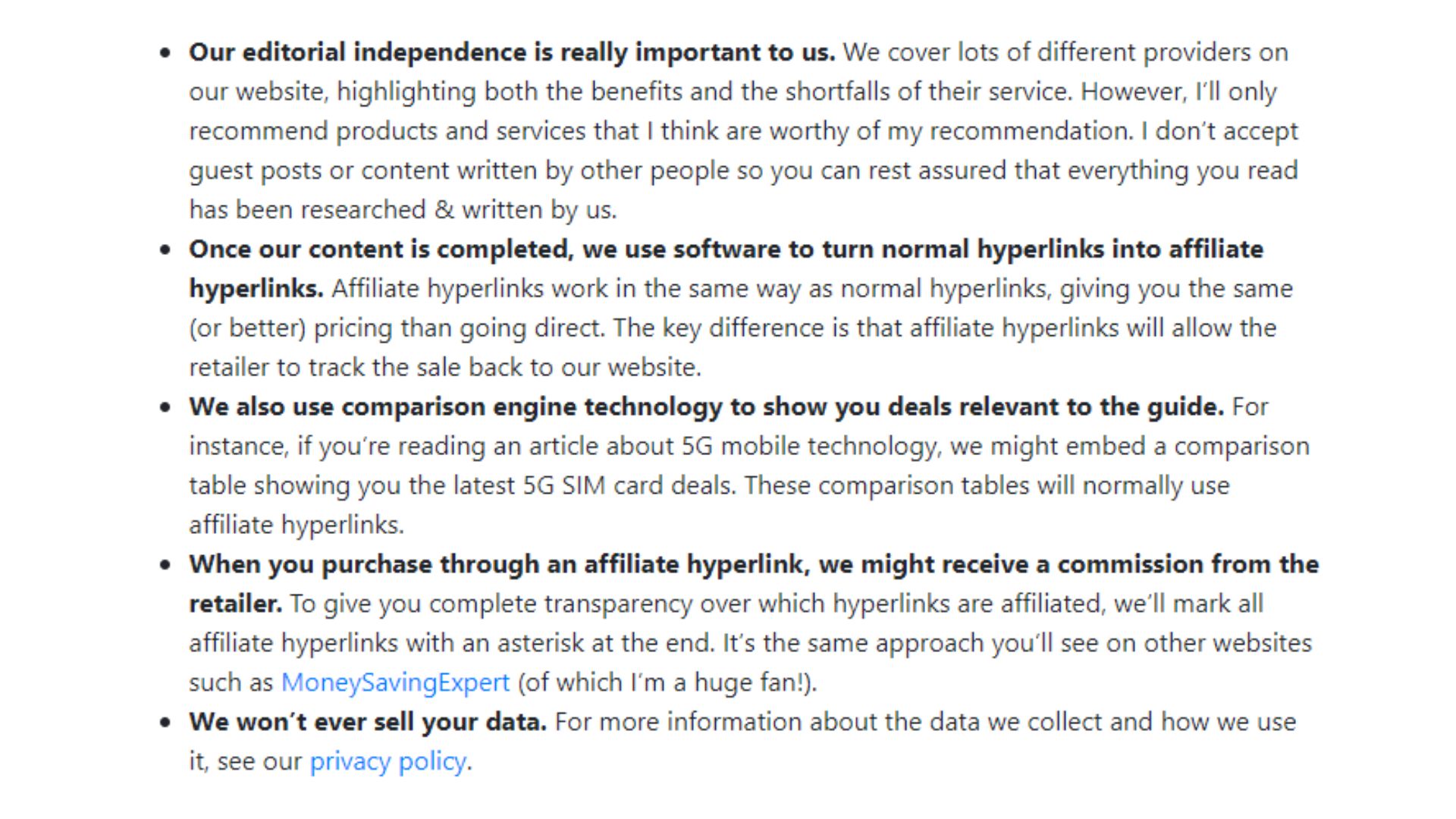
This disclosure is effective because it:
- Clearly communicates the site’s use of affiliate links
- Connects with the reader by using “you” and “your”
- Provides a relatable reason for the affiliate commission, emphasizing the site’s commitment to producing high-quality content
Points of Measure
Points of Measure is a fashion education platform founded by Natalie, who spent over $200k on traditional fashion education to create the platform.
Points of Measure takes a similar approach to the previous example.
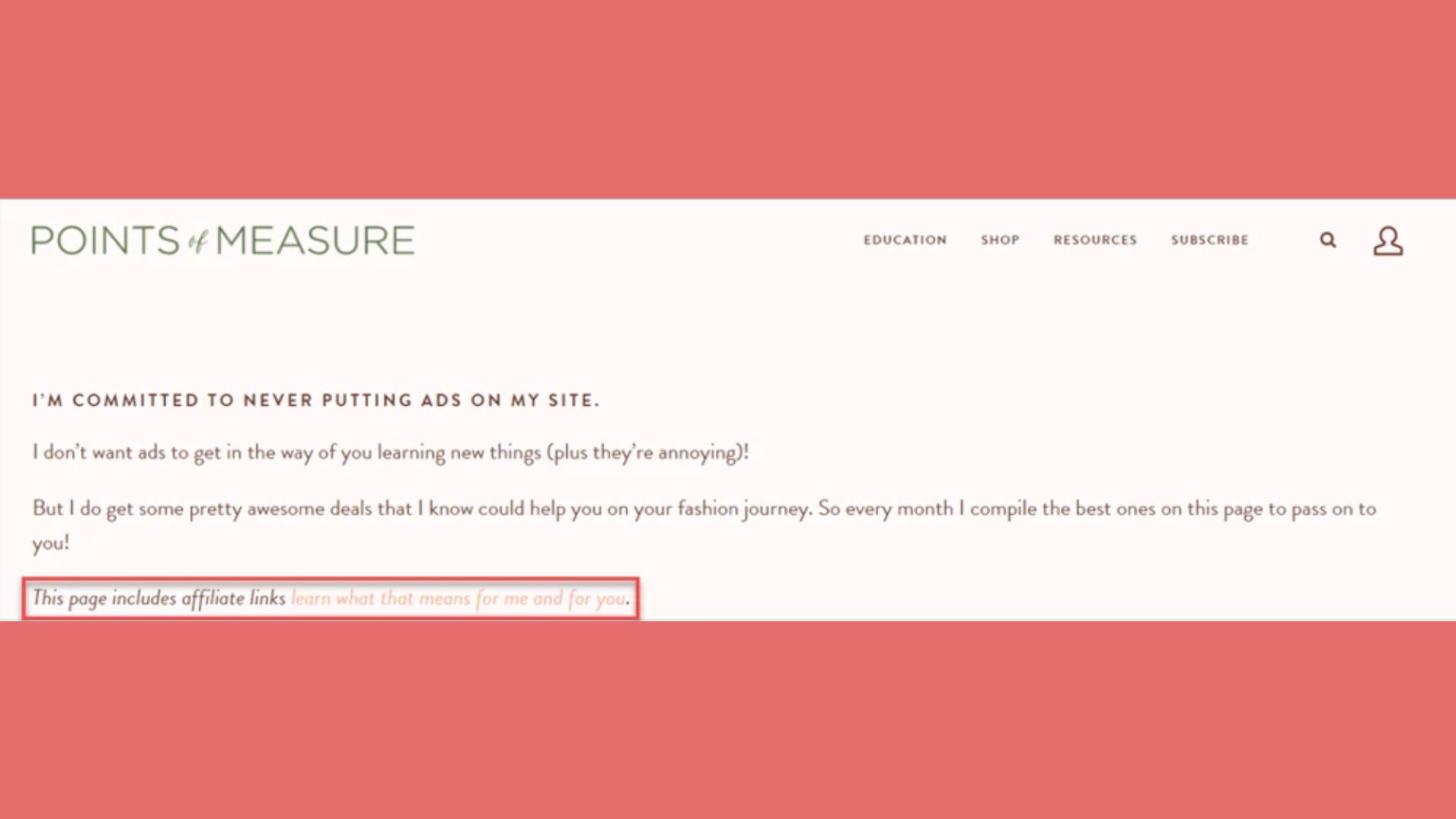
They offer a clear statement along with a contextual link to their complete affiliate disclosure.
However, one potential drawback is the assumption that the reader is familiar with the concept of an affiliate link.
Making Sense of Cents
Michelle at Making Sense of Cents is a fantastic and super successful blogger. Many have taken a few of her courses, and she really nails her disclosures.
She has this upfront disclaimer text before her articles, and she links to a full disclosure page with some straightforward info about FTC compliance.

In a nutshell, she covers all the bases and makes sure her audience is in the loop when something’s sponsored or includes an affiliate link.
Thanks to her transparency, Michelle has built a loyal and growing audience that knows exactly what to expect from her blog.
The Shop Files
The Shop Files, a website catering to online shop owners with resources and courses, effectively communicates its affiliate marketing activities through well-placed disclosures.
The Shop Files uses a smart approach, starting its affiliate disclosure with a ‘heads up’ to grab attention. The bolded text and placement at the top of the page ensure it’s easily noticeable. This is an effective way to inform readers transparently and concisely.
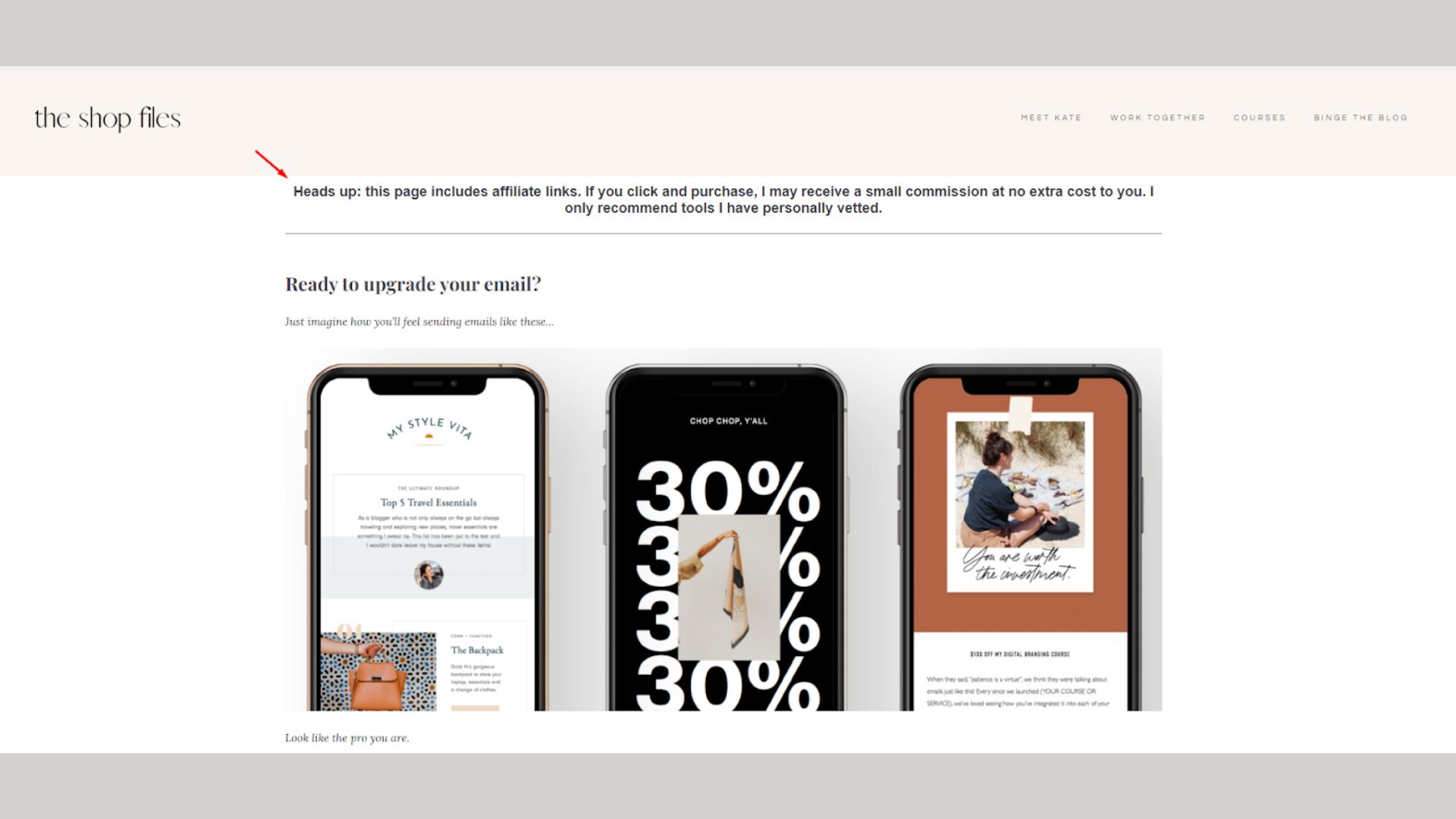
It also gets straight to the point, stating, “This page includes affiliate links,” and reassures the reader, “I only recommend tools I have personally vetted.
This concise and transparent three-sentence-long disclosure maintains openness about affiliate links and builds trust by emphasizing personal vetting of recommended tools.
The three-sentence disclosure gets straight to the point by mentioning affiliate links immediately.
Guide ‘Em
Guide ‘Em is a fresh affiliate site; they do affiliate marketing right from the get-go.
In their affiliate disclosure, they mention having affiliate links in their content.
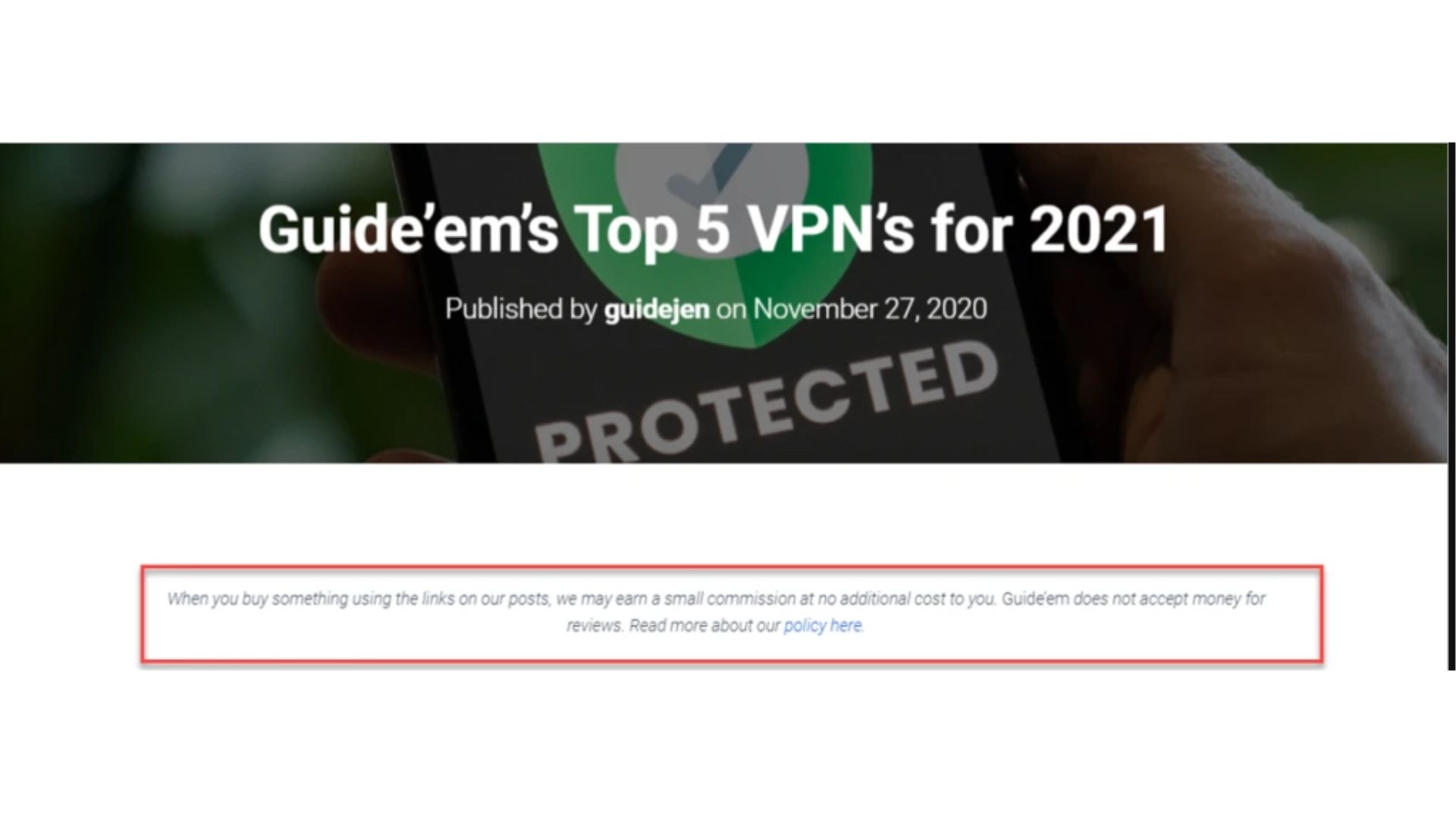
But what stands out is their promise: “We do not accept money for reviews.” This means their reviews are honest, not swayed by payment.
The Importance of Affiliate Disclosure
An affiliate disclosure is essential because the Federal Trade Commission (FTC) rules 2009 require a clear and noticeable disclosure of any business relationship.
The FTC says if the person promoting a product has a connection with the seller that could affect the endorsement’s credibility, it must be disclosed. This is especially important when the audience wouldn’t expect such a connection.
In a suggested update in 2020, the FTC gave more details about affiliate disclosures, focusing on important connections between endorsers and the selling company. These connections can include various relationships like business, family, or personal ties.
Imagine you’re looking for a new phone and find a tech review blog suggesting a specific model as the “ultimate device.” Excitedly, you click their link to buy it, only to get a malfunctioning phone that doesn’t meet your expectations. Later, you learn the blogger praised the phone just for the money they got from affiliate links.
This situation is what the FTC rules try to stop. Even though it might seem like extra work, these rules are there to protect you from tricky practices.
The main idea is simple – ads should be truthful and not trick you. The goal is to ensure bloggers and influencers are honest about anything that might affect your choices, especially when it involves affiliate links.
Using an affiliate link disclosure is important because some marketers might promote not-so-great products just for money. Since many people might not fully understand affiliate marketing, a clear disclosure is needed.
This disclosure simply says you’ll earn a commission for endorsing a specific affiliate program. This not only follows FTC rules but also helps you know if you want to use that affiliate link or not.
Who Needs Affiliate Disclosures?
Who should bother with affiliate disclosures?
Well, anyone who promotes products or services of other companies in exchange for a commission on sales or leads generated through their unique affiliate links.
People who need affiliate disclosures include:
- Celebrities
- TV Personalities:
- Social Media Influencers
- Bloggers
- Reviewers
The main idea is to be transparent about your connections when promoting products.
Where to Place Affiliate Disclosure?
According to the FTC guidelines, making your affiliate disclosures clear and easy to spot is crucial, ideally right next to your affiliate links or mentions of endorsed products.
Every page that talks about a sponsored item includes an affiliate link or endorses a product should have an affiliate disclosure.
While it’s important to have disclosures on every page with affiliate content, you might also consider having a separate page where you dive deeper into your relationships with sponsors and affiliate marketers– call it your affiliate disclosure page.
So where you should avoid adding your affiliate disclosure:
- Ensure your affiliate disclosure is not buried within your site’s ‘Privacy Policy’ or ‘Terms of Service’; keep it easily visible.
- Avoid placing it in a hard-to-find menu or submenu – make it accessible.
- Refrain from relying solely on mentioning affiliate links in your ‘About Us’ page; provide a more prominent placement.
- Don’t confine your disclosure to the footer; position it visibly within the content. Never attempt to minimize, hide, or obscure your affiliate disclosure statement; maintain transparency with your audience.
Wondering where to put your affiliate link disclosures?
It’s advisable to position your affiliate disclosure near your recommendation. While there’s no specific law dictating its exact location.
Some bloggers stick them right at the beginning of every blog post, email, or social media posts – not a bad idea at all.
Another option is to include it in the template you use for each page, so it’s there without you having to think about it every time.
Useful Tips for Affiliate Disclosure
To assist you in creating an effective and customized affiliate disclosure, here are some valuable tips to consider.
Make it clear and visible
The FTC says your affiliate disclosure needs to be “conspicuous”, like right where people can’t miss it. Think about putting it at the very start of your content.
For a blog post, put it right at the top; for a YouTube video, place it at the start; and for a social media post, position it right at the beginning of your post or video.
Equally important is ensuring the disclosure is clearly visible. Placing it at the top of an article with a tiny font size 6 and a light gray font color against a white background won’t meet the affiliate disclosure requirements. Your affiliate disclosure needs to stand out and be easy to read.
Keep it short and simple
Usually, an affiliate link disclosure doesn’t need to be lengthy – a few sentences will do, unless your affiliate program insists on a longer one.
But here’s a tip: instead of sticking to boring industry terms, you can get a bit creative with your disclosure.
Let your readers know what’s going on with a simple disclosure like this:
“Company X sent me [name of product], and I really like it.”
Or, if you’re starting a quick video:
“The products I’m using in this video were given to me by their makers.”
No need to be super fancy; just keep it straightforward:
“If you buy something after clicking this link, I might earn a few bucks from it.”
If short disclaimers make you unsure, think about using a disclosure link. This link can take your readers to a detailed disclosure page. It’s a smart move, especially if you want to avoid unexpected visits from the Federal Trade Commission.
Use disclaimer hashtags
Use shorthand for your affiliate links when dealing with character limits on social media. Social platforms often restrict post sizes, and on Twitter, for instance, fitting a strong pitch and a full disclosure in one tweet is a challenge.
Many influencers opt for a one-word affiliate disclaimer hashtag.
Popular hashtags for social media affiliate disclosures include:
#ad
#promo
#sponsored
#pitch
#plug
Avoid using hashtags like #affiliatelink or #ambassador, as these concepts may not be universally recognized. We recommend using #ad, #promo, and #sponsored, although #sponsored is a bit long for Twitter and can affect your tweet’s length.
Infuse your posts with personality
Many marketers discover an affiliate passive income disclosure they like and simply copy it word for word, but that’s not the best approach.
Instead of copying, why not inject creativity and craft your affiliate link disclosures? Let’s take a look at this example:
Melissa Giroux makes money through her travel blog, A Broken Backpack. She lets people know about it in different parts of her site, but our favorite spot is on the disclaimer and privacy policy page.
She says: “If you click on my affiliates/advertisers links, I am going to receive a tiny commission. AND… Most of the time, you will receive an offer. Win/Win! The affiliate products that I advertise are the ones I believe in.”
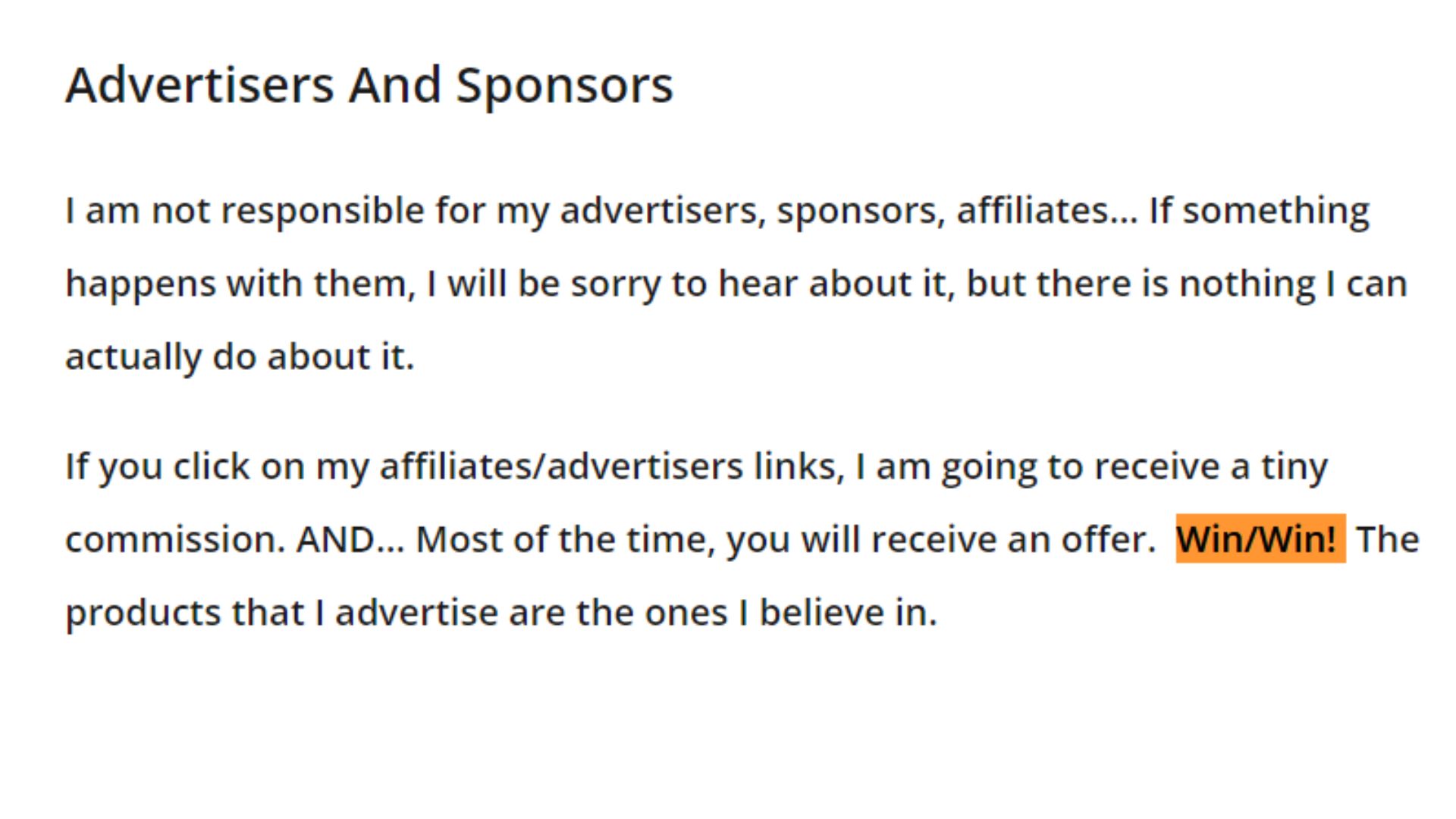
Feel free to personalize your affiliate disclosure to match your style—it doesn’t have to be overly formal.
Follow your affiliate program’s rules
Joining different affiliate marketing programs often means dealing with distinct disclosure requirements. These affiliate programs rarely have the same rules, and some may ask for specific disclosures depending on whether you’re promoting through a blog post, social media, or email.
For instance, Amazon Associates and other programs might require you to include certain language in your disclosure page.
FAQs
- Is it necessary to disclose every affiliate link?
Yes, you must tell people about every affiliate link. It’s a rule from the FTC to be open. If you don’t, you could get into trouble and lose people’s trust. So, always share this info, to be honest and follow the rules in affiliate marketing.
- How to write and add an affiliate disclosure?
To write and add an affiliate disclosure, explain in simple words that you may earn a commission if people click on your links. Be clear and honest. Add it near the link using simple language. You can write, “I may earn money if you buy through my links.” This helps follow the rules and be transparent.
- How to automatically add affiliate disclosure to the top of all my posts?
Automatically add an affiliate disclosure to the top of all your posts using plugins or widgets. Find a tool that lets you consistently place the disclosure. It ensures compliance by placing the disclosure prominently, saving you time and effort on each post.
- What happens if I don’t disclose an affiliate link?
Not disclosing an affiliate link could lead to legal requirement issues and harm your trust with your audience. It’s against FTC guidelines. Always disclose to be transparent. If you don’t, you risk consequences like fines or losing credibility. Disclosure is essential for honesty and following ethical guidelines in affiliate marketing.
- How can I make an effective affiliate disclosure?
Make an effective affiliate disclosure by using simple language. Clearly state you may earn a commission from links. Place it prominently near links, ensuring visibility. Keep it concise, honest, and easy to understand. Following the business practice builds trust, complies with guidelines, and promotes transparency in your affiliate marketing efforts.
- How to disclose affiliate links on multiple platforms?
Disclose affiliate links on various platforms by adapting your disclosure to each platform’s rules. Use clear and simple language, ensuring visibility. Follow each platform’s guidelines to maintain transparency. Customize your disclosure for each medium, providing honest information about your affiliate links. Consistent and platform-specific disclosures help you adhere to ethical standards.
Last words
We hope that these examples and ideas will give you a good starting point for creating your own disclosure.
While templates are available, it’s beneficial to tailor your disclosure to fit your blog, brand, and personality. Don’t stress too much about perfection; the key is to have a disclosure in place.
In blogging, getting your disclosure live is more crucial than achieving perfection.










